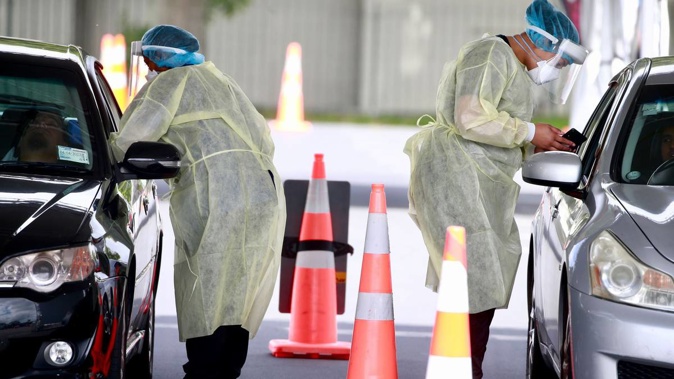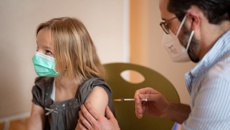
OMICRON LATEST
* Omicron threat: Red v orange settings - how life will change
* No lockdowns - but critics say Govt still doesn't have an Omicron plan
* Matthew Hooton: PM's Omicron choice horrific but necessary
* Claire Trevett: PM's warning to NZ - prepare for the Omicron winter
Almost 2000 Omicron cases a day - 10 times the Delta peak - are expected in the Auckland region in just six weeks in the event of an outbreak, according to latest modelling.
But it is expected to be a rapid rise and fall, and with less of an impact on the hospital system than the Delta outbreak, leading modeller Dr Gary Jackson to label it "moderately reassuring".
However, the Counties Manukau DHB's director of population health's comments come with the caveat that vaccination rates and boosters must continue to rise, and people - as has occurred thus far - continue to adhere to restrictions under the traffic light system.
Meanwhile, another modeller working on a yet-to-be-completed nationwide project says those models could be on the conservative side, with potential for up to 10,000 Omicron cases a day across the country and the risk of overwhelming the health system.
There are currently just five cases of Omicron suspected to have been in the community.
However, the number of Omicron cases at the border continues to rise, with 440 reported since December, compared to 32 of Delta.
Responding to Prime Minister Jacinda Ardern's announcement about what would happen if such an outbreak happened, National Party leader Chris Luxon told Newstalk ZB "it just feels like we've wasted time yet again".
He said he expected a lot more in the Government's plan to attack an outbreak of Omicron in the community.
Luxon acknowledged that the lack of rapid antigen testing was a key thing that needed to be addressed as soon as possible.
"We need tens of millions of these tests," Luxon said.
Speaking to Newstalk ZB's Tim Dower, Luxon said more beds were still needed in intensive care units if an Omicron outbreak were to happen.
He said more information and clarity should have been provided around how the country would react if the supply chain, in particular, was affected if workers became infected and therefore had to go into isolation.
On the traffic light system, Luxon said it was still confusing and people still do not know what the rules are in a red or orange setting.
"You need a risk management system...and it's just not there yet."
With the highly-infectious variant sweeping the globe, Ardern yesterday said it was a matter of when, not if, there was an outbreak here.
Modelling she had seen was highly variable, but cases would be at "a level we have not experienced before".
Despite this Ardern ruled out a return to lockdowns, and instead said the Government would shift the entire country to the red setting within 48 hours in the event of an outbreak.
Jackson said their models were based on international comparisons, mostly Australia which had a more similar risk profile compared to Europe, and while still "some time away" from being fully developed would be useful in preparations.
Using a hypothetical start date of February 1, Omicron case numbers across Auckland's three DHBs - Counties Manukau, Waitematā and Auckland - were projected to peak at about 1500 to 1800 a day by mid-March through April, before dropping away to 150 to 330 a day through May to September.
Over this period they modelled about 175 to 190 hospitalisations a month due to Omicron in March and April, falling to 45 to 70 throughout May to September.
Those requiring intensive care numbered between 10 to 20 across March and April, falling to five to 10 across May to September. Their models did not look at death rates.
The models showed a rapid increase in Omicron cases from the start of any outbreak over six weeks, levelling off over about four weeks and then dropping over another six week period.
"What we've seen overseas is a much more rapid rise in cases, a doubling every three to five days," Jackson said.
Once established, the infection rate was expected to be twice that of the Delta variant for both vaccinated and unvaccinated, Jackson said.
However, it was expected emergency departments would run at 25 per cent lower than with Delta, Jackson said.
"While we are finding it to be more infectious it appears to stay in the upper airway, so behaving more like a cold than pneumonia.
"Majority of people appear to have it much milder, but it is still a bell curve and people at the extremes, and especially the unvaccinated, will still get very sick."
An initial surge was also expected among those aged under 30, also lowering the impact on hospitals, Jackson said.
On the veracity of the numbers Jackson said cases could "easily be double or triple", but they were optimistic given how New Zealand had responded to outbreaks in the past and high vaccination rates.
Jackson said overall the models were "moderately reassuring" with the traffic light system expected to manage the outbreak, and high vaccination rates moderating the impact.
However, this didn't mean the variant should be allowed in and Jackson said every extra week that allowed vaccinations and booster rates to increase would help minimise impacts.
Covid-19 modeller Professor Michael Plank said work he and others had been doing modelling a national outbreak also showed thousands of cases a day "if not more than 10,000".
He agreed based on overseas examples it was a small fraction ending up in hospital, however the sheer volume of cases and short timeframe meant the health system could still be overwhelmed.
Plank said most critical mitigation continued to be vaccinations and boosters.
Counties Manukau DHB clinical director Dr Vanessa Thornton said given high numbers of infections, they were expecting their hospitals to come under pressure, which could impact other operations.
"Health sector workforce issues that existed prior to the commencement of this pandemic remain.
"We will prioritise staffing of all our critical services, and continue with as much elective surgery and as many outpatient clinics where we have the resources to deliver the services and care."
Take your Radio, Podcasts and Music with you









